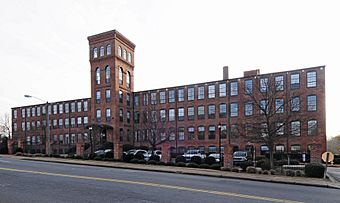Mills Mill facts for kids
Quick facts for kids |
|
|
Mills Mill
|
|

Mills Mill, 2012
|
|
| Location | 400 Mills Avenue, Greenville, South Carolina |
|---|---|
| Area | six acres |
| Built | 1896 |
| Architectural style | Romanesque Revival |
| NRHP reference No. | 82003861 |
| Added to NRHP | July 1, 1982 |
Mills Mill was a large factory in Greenville, South Carolina, that made cotton cloth. It operated from 1897 to 1978. Later, in the 2000s, the old factory building was changed into modern apartments called lofts. This special building is listed on the National Register of Historic Places, which means it's an important historical site.
Contents
History of Mills Mill
Starting the Cotton Mill
The Mills Manufacturing Company was started in the mid-1890s by a businessman named Otis Prentiss Mills (1840-1915). He was from Henderson County, North Carolina, and had been an officer in the Confederate army. In 1896, his company got permission to build the brick factory. They built it just outside the city of Greenville to avoid paying city taxes. It was also built near Brushy Creek, which provided water for the machines and a pond.
Mr. Mills also convinced the Southern Railway to build a special train track, called a siding, right to the mill. This made it easy to bring in materials and ship out finished cloth. In 1897, the mill opened. It had 5,000 spindles (parts of machines that twist cotton into thread) and about 200 workers. Most of these workers were farmers from the mountains of North and South Carolina.
Life in the Mill Village
By 1903, a small town, or "mill village," had grown around the factory. It had 120 houses and about 1,000 people living there. By 1907, the mill had 450 employees and 27,000 spindles. It made cotton bed sheets and different kinds of fabric like twills and satin.
Workers in the village could let their cows graze in the nearby fields. They also had small sheds for pigs and chickens behind their homes. The mill also built a company store where workers could buy supplies. There was a church that both Baptist and Methodist groups used, and a YMCA (Young Men's Christian Association) that had social workers to help the community.
Changes in Leadership
When O.P. Mills passed away in 1915, his son-in-law, Walter B. Moore, took over. Moore had experience in textile factories and managed the mill in a way that meant he cared for his workers like a father figure. He hired a landscape architect (someone who designs outdoor spaces) to make the mill grounds look nice. He also made sure all the mill village houses got running water and a sewer system.
After Moore died in 1918, the mill was sold to Alan Graham. In 1920, Graham sold it to the Reeves Brothers Company from Spartanburg, South Carolina. In the 1920s, the mill built even more houses in the village. It also sponsored a baseball team called the Mills Mill Millers, which played in a textile league. By the late 1930s, about 1,200 people lived in the village.
Challenges and Closure
The Great Depression, a time of economic hardship, hit the textile industry early. To try and make more money, the mill management tried to get workers to produce more cloth without extra pay. Workers called this the "stretch-out." In May 1929, 500 workers went on strike. They wanted the "stretch-out" to stop, a 20% pay raise, and fair treatment for union members. The mill president asked them to return to work, but they refused until July. Eventually, the local factory owners promised to stop night work for women and young people under 18. However, the workers didn't get their other demands. Mills Mill employees did not join the big national textile workers strike of 1934.
During World War II, the mill worked day and night, seven days a week. It made a special fabric called herringbone for Marine uniforms. Mills Mill continued to do well right after the war. However, the Reeves Brothers Company sold the village houses. They also stopped supporting the sports teams and helping with community upkeep and security.
In the 1970s, factories in the United States faced more competition from foreign countries. In 1977, Reeves Brothers let go of 200 workers. The next year, in 1978, the factory closed its doors for good.
After the Mill Closed
New Life for the Building
Many textile mills built around the year 1900, especially in the Piedmont region, were hard to update for modern cloth production. However, Mills Mill had a "very elegant design." It was also located near I-185 and the growing Greenville Hospital System.
In 1982, the mill was added to the National Register of Historic Places. In 1985, the Greenville County Redevelopment Authority made big improvements to the village's water and drainage systems. They also helped pay to fix up 90 houses near what had become a main road in Greenville. The old YMCA building was turned into apartments. From 1979 to 1996, shops and restaurants operated out of the former mill building.
In 2004, a company called Centennial American Properties changed the mill into apartments called condominia. These apartments had cool features like 16-foot ceilings, huge windows, giant pine wood beams, and exposed red brick walls. The developers also added a club room, a gym, a swimming pool, and nicely designed outdoor areas for the residents.



